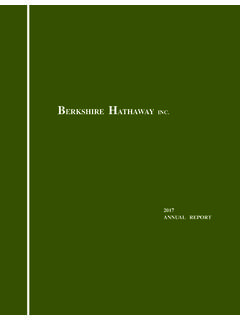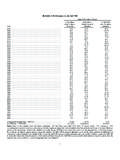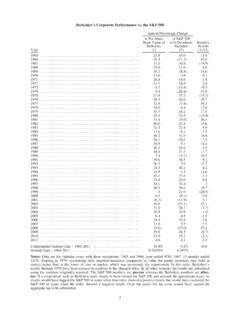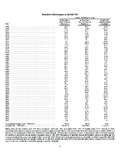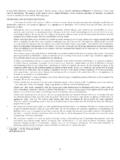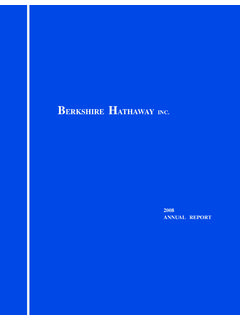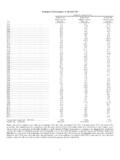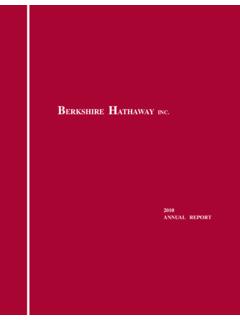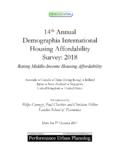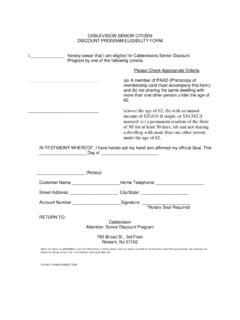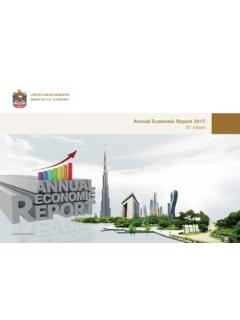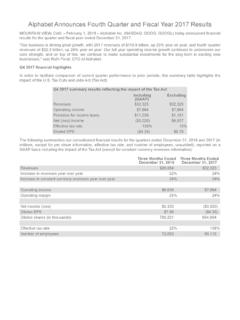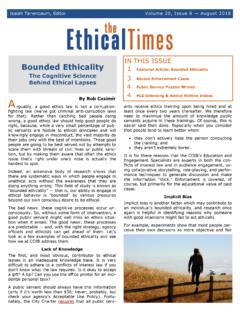Transcription of Berkshire’s Corporate Performance vs. the S&P 500
1 Berkshire s Corporate Performance vs. the S&P 500 annual Percentage ChangeYearin Per-ShareBook Value ofBerkshire(1)in S&P 500with DividendsIncluded(2)RelativeResults(1)-( 2) ( ) ( ) ( ) ( ) ( ) ( ) ( ) ( ) ( ) ( ) ( ) ( ) ( )( ) ( ) ( ) ( ) ( )( ) ( ) ( ) ( ) ( )Compounded annual Gain Gain ,518%9,841%Notes:Data are for calendar years with these exceptions: 1965 and 1966, year ended 9/30; 1967, 15 months ended12/31. Starting in 1979, accounting rules required insurance companies to value the equity securities they hold atmarket rather than at the lower of cost or market, which was previously the requirement.
2 In this table, Berkshire sresults through 1978 have been restated to conform to the changed rules. In all other respects, the results are calculatedusing the numbers originally reported. The S&P 500 numbers arepre-taxwhereas the Berkshire numbers areafter-tax. If a corporation such as Berkshire were simply to have owned the S&P 500 and accrued the appropriate taxes, itsresults would have lagged the S&P 500 in years when that index showed a positive return, but would have exceeded theS&P 500 in years when the index showed a negative return. Over the years, the tax costs would have caused theaggregate lag to be HATHAWAY the Shareholders of Berkshire Hathaway Inc.
3 :Berkshire s gain in net worth during 2013 was $ billion. That gain wasafterour deducting $ billionof charges meaningless economically, as I will explain later that arose from our purchase of the minorityinterests in Marmon and Iscar. After those charges, the per-share book value of both our Class A and Class B stockincreased by Over the last 49 years (that is, since present management took over), book value has grownfrom $19 to $134,973, a rate of compounded annually.*On the facing page, we show our long-standing Performance measurement: The yearly change inBerkshire s per-share book value versus the market Performance of the S&P 500.
4 What counts, of course, is per-shareintrinsicvalue. But that s a subjective figure, and book value is useful as a rough tracking indicator. (Anextended discussion of intrinsic value is included in our Owner-Related Business Principles on pages 103 - principles have been included in our reports for 30 years, and we urge new and prospective shareholders toread them.)As I ve long told you, Berkshire s intrinsic value far exceeds its book value. Moreover, the difference haswidened considerably in recent years. That s why our 2012 decision to authorize the repurchase of shares at 120%of book value made sense.
5 Purchases at that level benefit continuing shareholders because per-share intrinsic valueexceeds that percentage of book value by a meaningful amount. We did not purchase shares during 2013, however,because the stock price did not descend to the 120% level. If it does, we will be Munger, Berkshire s vice chairman and my partner, and I believe both Berkshire s book value andintrinsic value will outperform the S&P in years when the market is down or moderately up. We expect to fallshort, though, in years when the market is strong as we did in 2013. We have underperformed in ten of our 49years, with all but one of our shortfalls occurring when the S&P gain exceeded 15%.
6 Over the stock market cycle between yearends 2007 and 2013, we overperformed the S&P. Through fullcycles in future years, we expect to do that again. If we fail to do so, we will not have earned our pay. After all, youcould always own an index fund and be assured of S&P Year at BerkshireOn the operating front, just about everything turned out well for us last year in certain me count the ways: We completed two large acquisitions, spending almost $18 billion to purchase all of NV Energy and amajor interest in H. J. Heinz. Both companies fit us well and will be prospering a century from the Heinz purchase, moreover, we created a partnership template that may be used by Berkshire infuture acquisitions of size.
7 Here, we teamed up with investors at 3G Capital, a firm led by my friend, JorgePaulo Lemann. His talented associates Bernardo Hees, Heinz s new CEO, and Alex Behring, itsChairman are responsible for operations.* All per-share figures used in this report apply to Berkshire s A shares. Figures for the B shares are1/1500thof those shown for is the financing partner. In that role, we purchased $8 billion of Heinz preferred stock thatcarries a 9% coupon but also possesses other features that should increase the preferred s annual return to12% or so. Berkshire and 3G each purchased half of the Heinz common stock for $ the Heinz acquisition has some similarities to a private equity transaction, there is a crucialdifference: Berkshire never intends to sell a share of the company.
8 What we would like, rather, is to buymore, and that could happen: Certain 3G investors may sell some or all of their shares in the future, andwe might increase our ownership at such times. Berkshire and 3G could also decide at some point that itwould be mutually beneficial if we were to exchange some of our preferred for common shares (at anequity valuation appropriate to the time).Our partnership took control of Heinz in June, and operating results so far are encouraging. Only minorearnings from Heinz, however, are reflected in those we report for Berkshire this year: One-time chargesincurred in the purchase and subsequent restructuring of operations totaled $ billion.
9 Earnings in 2014will be Heinz, Berkshire now owns 81 2companies that, were they stand-alone businesses, would be in theFortune 500. Only 4911 2to Energy, purchased for $ billion by MidAmerican Energy, our utility subsidiary, supplies electricityto about 88% of Nevada s population. This acquisition fits nicely into our existing electric-utilityoperation and offers many possibilities for large investments in renewable energy. NV Energy willnotbeMidAmerican s last major acquisition. MidAmerican is one of our Powerhouse Five a collection of large non-insurance businesses that, inaggregate, had a record $ billion of pre-tax earnings in 2013, up $758 million from 2012.
10 The othercompanies in this sainted group are BNSF, Iscar, Lubrizol and the five, only MidAmerican, then earning $393 million pre-tax, was owned by Berkshire nine yearsago. Subsequently, we purchased another three of the five on an all-cash basis. In acquiring the fifth,BNSF, we paid about 70% of the cost in cash, and, for the remainder, issued shares that increased thenumber outstanding by In other words, the $ billion gain in annual earnings delivered Berkshireby the five companies over the nine-year span has been accompanied by only minor dilution. That satisfiesour goal of not simply growing, but rather the economy continues to improve in 2014, we can expect earnings of our Powerhouse Five toimprove also perhaps by $1 billion or so pre-tax.

